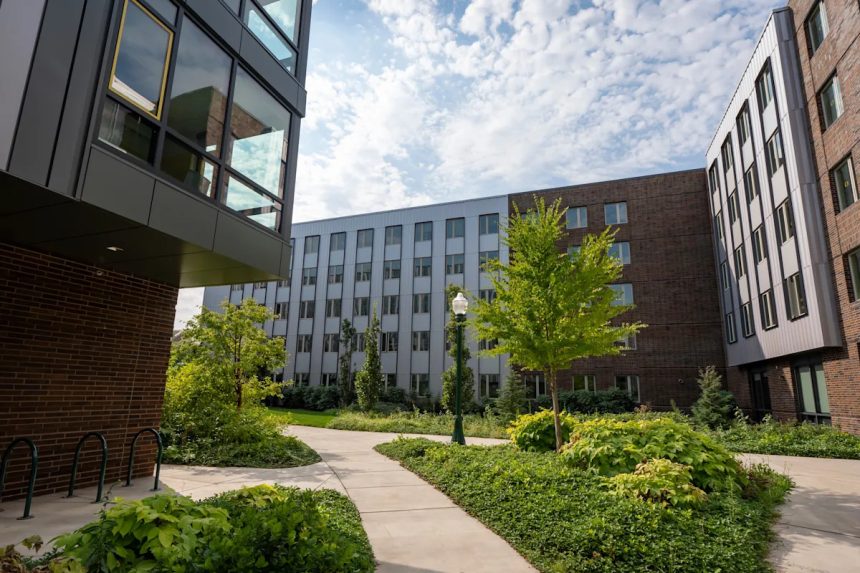University of Oregon’s 11 dormitories each offer a distinct experience, with some having a rich history while others are brand new.
“Some students really like the new, shiny rooms that have an en suite bathroom. Other students tend to be a little bit more on the nostalgic side,” said Associate Vice President for Student Services and Enrollment Management Michael Griffel. “As far as popularity goes, they’re all requested at pretty high rates.”
Whether you’re a student moving in, an anxious parent or a UO alum with distinct dorm memories, vote for your favorite dormitory. The poll will close at 5 p.m. on Sept. 23.
Move-in days are coming Sept. 25 and 26. Here’s a brief description of the on-campus student housing UO offers.
How many students live on campus at UO?
Most of the halls have flex capacity, meaning beds can be added or removed as needed. Between the residence halls, capacity ranges from 5,100 to 6,045 beds. UO stated typically, the halls are configured for about 5,700 students.
Griffel said approximately 25% of students live on campus. UO freshmen are required to live on campus for their first year, unless they are granted an exemption. Exemptions may be granted to students living at home, students over 21 and students with disabilities that can’t be accommodated on campus.
For the most part, UO’s dorms are all mixed disciplinaries and mixed genders.
Greenery lines walkways between the New Residence Hall, left, and Yasui Hall on the campus of the University of Oregon.
Barnhart Hall — off-campus experience
Built in 1966, Barnhart Hall has a long history on campus. Originally called College Inn, Barnhart was previously privately owned, off-campus student housing at 1000 Patterson St., northwest of campus. It was later bought by the state, allocated to UO and renamed University Inn, according to UO archives. In 2001, it was renamed after H. Philip Barnhart, a former university housing director.
Because it started off as private housing, Barnhart has private bathrooms, similar to some of the modern halls.
Barnhart also has a dining hall best known for its “Barnhart Brunch” on Saturday and Sunday mornings.
-
Room types: single, double and triple
-
Other amenities: basketball courts, community kitchenette, in-building laundry, learning commons, student lounges and elevators.
Carson Hall — UO’s oldest dormitory
UO’s oldest dormitory is Carson Hall. Originally built as a women’s dorm, Carson now has multi-gendered floors with single-gendered wings. The hall was named after Luella Clay Carson, UO professor and dean of women, according to UO archives.
Carson is located at the heart of campus, just east of Erb Memorial Union. It also has its own dining hall.
-
Room types: single, double and triple
-
Other amenities: classroom space, elevator, study and lounge spaces, community bathrooms and in-building laundry.

Maddi Coultrap, right and her mom Ronda Marchica carry Coultrap’s belongings to her fourth floor dorm room during move-in day in 2022 at the University of Oregon.
Earl Hall — undergoing exterior remodel
Earl Hall was constructed in 1955 as a men’s dormitory. It was named after Virgil D. Earl, a UO alum and former athletics director, according to UO archives. Earl now has multi-gendered floors.
Earl is connected to academic building Straub Hall, an academic building with new classroom technology, study spaces, and community areas. Earl is the only hall without elevator access to all floors. It has elevator access just to the learning commons area.
Earl is currently undergoing an exterior remodel, as existing steel-frame windows will be replaced with energy-efficient, operable vinyl windows. The surrounding tile facade will be replaced with metal siding, and wooden storefronts on the ground floor will be restored, according to the UO website.
-
Room types: single and double
-
Other amenities: classroom space, community kitchen, study and lounge spaces, private bathrooms on each floor and in-building laundry.
Global Scholars Hall — variety of options
One of the newer dormitories, Global Scholars Hall is located on the east side of campus, neighboring the Museum of Natural and Cultural History. The hall has multi-gendered floors and is a mix of traditional dormitories with communal bathrooms and suite-style rooms with bathrooms shared between two to six students.
Its dining hall, Fresh Marketcafé, is a central part of the main level. The common area also features classroom spaces, a demonstration kitchen, music practice rooms and study areas. Global Scholars also houses UO’s Center for Undergraduate Research and Engagement.
-
Room types: single, double, triple and various suits.
-
Other amenities: classroom space, community kitchen, study and lounge spaces, a mix of private and community bathrooms, elevator, music practice room and in-building laundry.
Justice Bean Hall — renovated in 2018
Another longtime UO dormitory, Justice Bean Hall, is located on the east side of campus, just south of Matthew Knight Arena. The dorm was renovated in 2018, fitted with new community spaces and room finishes.
The hall was named for UO alum and former Oregon Supreme Court Chief Justice Robert Sharp Bean, according to UO archives. Bean has two large courtyards that break up the complex.
-
Other amenities: elevators, study and lounge spaces, community kitchens, private bathrooms on each floor, faculty offices, classrooms and in-building laundry.
Kalapuya Ilihi — ready to reopen after two years of repairs
Kalapuya Ilihi is named in honor of the Indigenous Kalapuya people of the Willamette Valley. The building is adjacent to the Many Nations Longhouse at the southeast corner of campus.
Kalapuya Ilihi operated for several years but was closed in July 2023 due to structural issues after cracks were found throughout the building. Griffel said repairs were made to ensure seismic stability and building functions.

The Kalapuya Ilihi residence hall at the University of Oregon will reopen to students this year after undergoing structural repairs.
As of summer 2025, the hall was already housing students in summer programs and will be fully open again this fall.
-
Room types: double and triple.
-
Other amenities: community kitchen, study and lounge spaces, maker-hacker space, seminar room, in-room bathrooms, elevator and in-building laundry.
Living Learning Center completed 2006
Living Learning Center was the university’s first residential construction project in 40 years. Completed in 2006, the hall has multi-gendered floors, classroom spaces, smart board study rooms and a performance hall.
Inside the LLC is a dining hall called Dux Bistro and a tutoring center called The Hub. LLC is located north of Hayward Field, tucked between Straub and Yasui halls.
-
Room types: double, triple and two-person suite.
-
Other amenities: classroom spaces, study and lounge spaces, community bathrooms, elevator and in-building laundry.
New Residence Hall — largest dormitory at UO
UO’s newest and largest residence hall, “New Residence Hall,” has yet to be officially named. It is located on Agate Street, just north of Hayward Field.
While also serving other programs, New Residence Hall is home to students in the Clark Honors College and the The Ballmer Institute for Children’s Behavioral Health.
-
Room types: double and triple.
-
Other amenities: community kitchen, study and lounge spaces, in-room bathrooms, elevator, music practice room, package center, service center and in-building laundry.
Riley Hall — UO’s smallest dormitory
UO’s smallest dormitory is Riley Hall. Similarly to Barnhart, Riley is located off the main campus at 650 E. 11th Ave. It was originally built by Sacred Heart Hospital to house nursing students, according to UO archives. In 1971, it was acquired by Northwest Christian University, now Bushnell University. UO bought the hall in 1987.
Riley Hall was renamed in 1989 after World War II veteran Harold “Pat” Riley, Jr.
-
Room type: single, double and two-person suite.
-
Other amenities: elevators, study and lounge spaces, community kitchens, community bathrooms, basketball courts and in-building laundry.
Unthank Hall — first phase in housing transformation
Unthank Hall was the first phase of the Hamilton Walton Transformation Project. Completed in 2021, the hall was named after DeNorval Unthank Jr. He was the first African American to graduate from the UO’s School of Architecture and Allied Arts, and he designed McKenzie and Bean halls on campus.
Unthank’s dining hall, PNW Public Market, touts nine venues with different cuisines. It is also home to the Student Welcome Center, which serves as the starting point for campus tours meant to entice prospective students.
Unthank is located next to Hamilton Hall, which will be demolished this fall.
-
Room types: single, double and triple.
-
Other amenities: community kitchen, study and lounge spaces, in-room bathrooms, elevator and in-building laundry.
Yasui Hall — apartment-style dorms for upperclassmen
The newly named Yasui Hall offers “apartment living” for students looking to live on campus after their first year. Each room has a kitchen with an oven, fridge, dishwasher and cabinets. Starting in fall 2025, the hall will host a new program supporting transfer students.
“Most people only live on campus while they’re going to college, and that’s typically four to five years at the most,” Griffel said. “There’s been a really strong demand for people to live on campus.”
Yasui Hall was named after the Yasui family, which has seen four generations of Ducks since Masuo and Shidzuyo Yasui immigrated from Japan in the 1990s. Yasui is located north of Hayward Field, hugging New Residence Hall.
-
Room types: micro studio, double studio and four-bedroom unit.
-
Other amenities: study and lounge spaces, in-room bathrooms, elevator, music practice rooms and in-building laundry.
Remembering Hamilton, Walton, Friendly and other past dormitories at UO
With all the newer residential buildings, several former halls no longer hold students, either having been demolished, on the demo list or serving other purposes.
The oldest former UO dormitory is Friendly Hall, built in 1893. According to UO archives, it was the first co-ed dormitory in the U.S., with two main entrances, one to the south for men and one to the north for women. While Friendly Hall still exists, it has operated as classroom space instead of housing since 1928 after Straub Hall was built.

Longtime friends Sophia Findley, left, and Elly Kjersten unpack as students begin to move into Hamilton Hall at the University of Oregon Thursday, Sept. 26, 2024.
Similarly to Friendly, Straub Hall was originally built in 1928 as a dormitory. Earl Hall was later added onto the building, then Straub was redesignated as classroom space in 1975, according to UO archives.
Walton Hall, built in 1959, was demolished to make way for Yasui Hall and New Residence Hall, an approximately $120 million project.
Hamilton Hall, built in 1961, is set to be demolished this fall. It will be replaced with a green space that will supplement the Humpy Lumpy Lawn where Unthank Hall was built.
Miranda Cyr reports on education for The Register-Guard. You can contact her at mcyr@registerguard.com or find her on Twitter @mirandabcyr.
This article originally appeared on Register-Guard: Guide to University of Oregon dormitories: Which is the best to live in?
- How many students live on campus at UO?
- Barnhart Hall — off-campus experience
- Carson Hall — UO’s oldest dormitory
- Earl Hall — undergoing exterior remodel
- Global Scholars Hall — variety of options
- Justice Bean Hall — renovated in 2018
- Kalapuya Ilihi — ready to reopen after two years of repairs
- Living Learning Center completed 2006
- New Residence Hall — largest dormitory at UO
- Riley Hall — UO’s smallest dormitory
- Unthank Hall — first phase in housing transformation
- Yasui Hall — apartment-style dorms for upperclassmen
- Remembering Hamilton, Walton, Friendly and other past dormitories at UO









